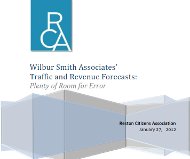4/10/2013
Study Documents Optimism Bias In Toll Road Traffic ForecastsStudy finds toll road industry plagued by inaccurate traffic forecasting.

Toll roads around the world are struggling. Moody's Investment Services on March 21 warned of a possible downgrade of the SH130 toll road in Austin, Texas because the 50 percent fewer people used the road than projected. In Australia, toll operator BrisConnections finally went bankrupt in February after its $4.8 billion Airport Link toll road in Brisbane failed to deliver. In Virginia, the newly opened 495 high occupancy toll lanes have continued to disappoint officials.
None of this is surprising according to a Virginia group, the Reston Citizens Association, which earlier this year released an extensive study of the problems inherent in toll road forecasting. A review of 104 toll roads around the world showed toll roads suffered from "optimism bias" that results in traffic forecasts being inflated by 25 to 30 percent, on average. The problem is more acute in the United States, where twenty-six toll roads reported 109 percent inflation in their forecasts, according to a National Highway Cooperative Research Program review.
Politicians use these revenue forecasts in deciding whether to build a toll road or convert existing lanes into toll lanes. The Reston-based group, which represents 65,000 residents, argues the firm Wilbur Smith and Associates (WSA) has provided inflated forecasts used by Virginia lawmakers and Metropolitan Washington Airports Authority (MWAA) board members regarding financing of the $6 billion Metrorail extension to Dulles International Airport. The report concluded WSA forecasts of other US tolling projects have in the past been inflated by an average of 118 percent.
"In the current context, such inaccuracies may lead to poor decisions by MWAA, county, and state, and federal leaders about whether to proceed with the Metrorail Silver Line and who pays and how construction costs should be paid," the report explained. "In particular, with Dulles Toll Road users pegged to pick up 54 percent or more of the line's construction costs -- now put at $3 billion --including 75 percent of Phase 2 construction costs, we believe it is important that public officials make a judicious decision based on the best information available."
Over the next forty years, the interest and total construction costs of the Metro line will top an estimated $15 billion, and the cost will be passed on to Dulles Toll Road users who will face $15 tolls within twenty years.
The report found that in making its traffic forecasts, Wilbur Smith and Associates selected the most favorable scenarios possible when estimating future population, economic growth and employment levels. The rosy scenarios frequently did not materialize, as WSA's predictions for Fairfax County employment in 2010 proved to be off by 300,000 workers. The result of the inflated numbers was that a 2009 WSA report doubled the estimated toll road revenue by 2030 compared to a 2005 WSA prediction.
Forecasts that predict big revenue are highly valued by tolling companies, but the danger is that the project based on inaccurate estimates will go bankrupt as expected revenue falters. The report cited the experience of California's Southern Connector, South Bay Expressway and San Joaquin Hills Toll Road; and Virginia's Pocahontas Parkway, each of which asked WSA to estimate traffic.
"In all four of the cases, the overestimates in WSA's traffic and revenue forecasts for these new toll roads were evident within a year or two of the beginning of toll operations," the report explained. "How long it took to move from that recognition to financial restructuring, sale, or bankruptcy depended largely on the financial reserves and access to alternative funding available to the toll road management... In the end, South Bay's equity investors were wiped out, bondholders took a major loss, San Diego had to take over the previously public-private partnership, and the value of the endeavor sunk by nearly half."
The net result has been that taxpayers are stuck with greater debt and drivers are hit with larger tolls. The report concludes the same fate is likely to befall the Dulles Toll Road.
A copy of the report is available in a 5mb PDF file at the source link below.


